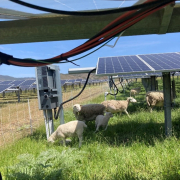Characterizing the Ecological Effects of Utility-scale Photovoltaic Arrays in Rangeland
By Dr. Seeta Sistla, Natural Resources Management and Environmental Sciences Department, Cal Poly, San Luis Obispo
With the dual growth of utility-scale solar energy and food production, fallowed agricultural landscapes represent a particularly promising area for the deployment of solar arrays because these systems have the potential to recover with shifts in management practices (Tscharntke et al., 2012; Wright et al., 2012). California is a national leader of both solar energy development and agricultural production. As water becomes scarcer and costlier, there is growing tension between land-use choices centered around maintaining conventional agricultural systems, transitioning land to renewable energy farming through solar energy development, shifting agricultural strategy (e.g., conventional to conservation farming), or alternate land uses (e.g., housing development).
Placing solar arrays on farmland and other human-modified landscapes represents a promising area to unite energy production with ecological restoration and the sustained conservation of ecologically valuable land. The potential for ecologically improving degraded landscapes with targeted solar array placement will be governed by biogeochemical interactions between abiotic and biotic factors (Figure 1). Despite the potential ecological and economic synergistic benefits that coupling these land uses could create, the impacts of solar arrays on fallowed farmland and other disturbed landscapes are not well understood.

To address this deficit, we are studying the direct and indirect effects of utility-scale solar energy in conjunction with sheep grazing on soil and plant characteristics. This work includes collaborating with agricultural stakeholders, undergraduate and graduate students, and solar developers (Figure 2).

To date, we have found that land in the direct footprint of the array panels hosts a plant community with increased nutrient content and forage quality and maintains a greener plant community for longer periods than the surround area. These findings likely reflect reduced water stress due to shading in our arid western landscapes, highlighting the potential synergy between carbon-free energy production, rangeland management, and water conservation (Figure 3). Our group continues to investigate these plant and soil responses to array placement at two solar sites on the Central Coast of California and looks forward to opportunities to collaborate with others.

References
Tscharntke, T., Y. Clough, T. C. Wanger, L. Jackson, I. Motzke, I. Perfecto, J. Vandermeer, and A. Whitbread. 2012. Global food security, biodiversity conservation and the future of agricultural intensification. Biological Conservation 151:53–59.
Wright, H. L., I. R. Lake, and P. M. Dolman. 2012. Agriculture-a key element for conservation in the developing world. Conservation Letters 5:11–19.



